Aditya Balu
Bidirectional Linear Recurrent Models for Sequence-Level Multisource Fusion
Apr 11, 2025Abstract:Sequence modeling is a critical yet challenging task with wide-ranging applications, especially in time series forecasting for domains like weather prediction, temperature monitoring, and energy load forecasting. Transformers, with their attention mechanism, have emerged as state-of-the-art due to their efficient parallel training, but they suffer from quadratic time complexity, limiting their scalability for long sequences. In contrast, recurrent neural networks (RNNs) offer linear time complexity, spurring renewed interest in linear RNNs for more computationally efficient sequence modeling. In this work, we introduce BLUR (Bidirectional Linear Unit for Recurrent network), which uses forward and backward linear recurrent units (LRUs) to capture both past and future dependencies with high computational efficiency. BLUR maintains the linear time complexity of traditional RNNs, while enabling fast parallel training through LRUs. Furthermore, it offers provably stable training and strong approximation capabilities, making it highly effective for modeling long-term dependencies. Extensive experiments on sequential image and time series datasets reveal that BLUR not only surpasses transformers and traditional RNNs in accuracy but also significantly reduces computational costs, making it particularly suitable for real-world forecasting tasks. Our code is available here.
NeRF-based Point Cloud Reconstruction using a Stationary Camera for Agricultural Applications
Mar 27, 2025Abstract:This paper presents a NeRF-based framework for point cloud (PCD) reconstruction, specifically designed for indoor high-throughput plant phenotyping facilities. Traditional NeRF-based reconstruction methods require cameras to move around stationary objects, but this approach is impractical for high-throughput environments where objects are rapidly imaged while moving on conveyors or rotating pedestals. To address this limitation, we develop a variant of NeRF-based PCD reconstruction that uses a single stationary camera to capture images as the object rotates on a pedestal. Our workflow comprises COLMAP-based pose estimation, a straightforward pose transformation to simulate camera movement, and subsequent standard NeRF training. A defined Region of Interest (ROI) excludes irrelevant scene data, enabling the generation of high-resolution point clouds (10M points). Experimental results demonstrate excellent reconstruction fidelity, with precision-recall analyses yielding an F-score close to 100.00 across all evaluated plant objects. Although pose estimation remains computationally intensive with a stationary camera setup, overall training and reconstruction times are competitive, validating the method's feasibility for practical high-throughput indoor phenotyping applications. Our findings indicate that high-quality NeRF-based 3D reconstructions are achievable using a stationary camera, eliminating the need for complex camera motion or costly imaging equipment. This approach is especially beneficial when employing expensive and delicate instruments, such as hyperspectral cameras, for 3D plant phenotyping. Future work will focus on optimizing pose estimation techniques and further streamlining the methodology to facilitate seamless integration into automated, high-throughput 3D phenotyping pipelines.
Accessing the Effect of Phyllotaxy and Planting Density on Light Use Efficiency in Field-Grown Maize using 3D Reconstructions
Mar 10, 2025Abstract:High-density planting is a widely adopted strategy to enhance maize productivity, yet it introduces challenges such as increased interplant competition and shading, which can limit light capture and overall yield potential. In response, some maize plants naturally reorient their canopies to optimize light capture, a process known as canopy reorientation. Understanding this adaptive response and its impact on light capture is crucial for maximizing agricultural yield potential. This study introduces an end-to-end framework that integrates realistic 3D reconstructions of field-grown maize with photosynthetically active radiation (PAR) modeling to assess the effects of phyllotaxy and planting density on light interception. In particular, using 3D point clouds derived from field data, virtual fields for a diverse set of maize genotypes were constructed and validated against field PAR measurements. Using this framework, we present detailed analyses of the impact of canopy orientations, plant and row spacings, and planting row directions on PAR interception throughout a typical growing season. Our findings highlight significant variations in light interception efficiency across different planting densities and canopy orientations. By elucidating the relationship between canopy architecture and light capture, this study offers valuable guidance for optimizing maize breeding and cultivation strategies across diverse agricultural settings.
AgriField3D: A Curated 3D Point Cloud and Procedural Model Dataset of Field-Grown Maize from a Diversity Panel
Mar 10, 2025Abstract:The application of artificial intelligence (AI) in three-dimensional (3D) agricultural research, particularly for maize, has been limited by the scarcity of large-scale, diverse datasets. While 2D image datasets are abundant, they fail to capture essential structural details such as leaf architecture, plant volume, and spatial arrangements that 3D data provide. To address this limitation, we present AgriField3D (https://baskargroup.github.io/AgriField3D/), a curated dataset of 3D point clouds of field-grown maize plants from a diverse genetic panel, designed to be AI-ready for advancing agricultural research. Our dataset comprises over 1,000 high-quality point clouds collected using a Terrestrial Laser Scanner, complemented by procedural models that provide structured, parametric representations of maize plants. These procedural models, generated using Non-Uniform Rational B-Splines (NURBS) and optimized via a two-step process combining Particle Swarm Optimization (PSO) and differentiable programming, enable precise, scalable reconstructions of leaf surfaces and plant architectures. To enhance usability, we performed graph-based segmentation to isolate individual leaves and stalks, ensuring consistent labeling across all samples. We also conducted rigorous manual quality control on all datasets, correcting errors in segmentation, ensuring accurate leaf ordering, and validating metadata annotations. The dataset further includes metadata detailing plant morphology and quality, alongside multi-resolution subsampled versions (100k, 50k, 10k points) optimized for various computational needs. By integrating point cloud data of field grown plants with high-fidelity procedural models and ensuring meticulous manual validation, AgriField3D provides a comprehensive foundation for AI-driven phenotyping, plant structural analysis, and 3D applications in agricultural research.
FUSE: First-Order and Second-Order Unified SynthEsis in Stochastic Optimization
Mar 06, 2025Abstract:Stochastic optimization methods have actively been playing a critical role in modern machine learning algorithms to deliver decent performance. While numerous works have proposed and developed diverse approaches, first-order and second-order methods are in entirely different situations. The former is significantly pivotal and dominating in emerging deep learning but only leads convergence to a stationary point. However, second-order methods are less popular due to their computational intensity in large-dimensional problems. This paper presents a novel method that leverages both the first-order and second-order methods in a unified algorithmic framework, termed FUSE, from which a practical version (PV) is derived accordingly. FUSE-PV stands as a simple yet efficient optimization method involving a switch-over between first and second orders. Additionally, we develop different criteria that determine when to switch. FUSE-PV has provably shown a smaller computational complexity than SGD and Adam. To validate our proposed scheme, we present an ablation study on several simple test functions and show a comparison with baselines for benchmark datasets.
Geometry Matters: Benchmarking Scientific ML Approaches for Flow Prediction around Complex Geometries
Dec 31, 2024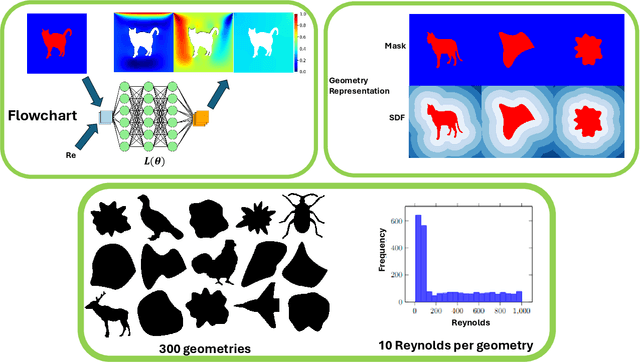
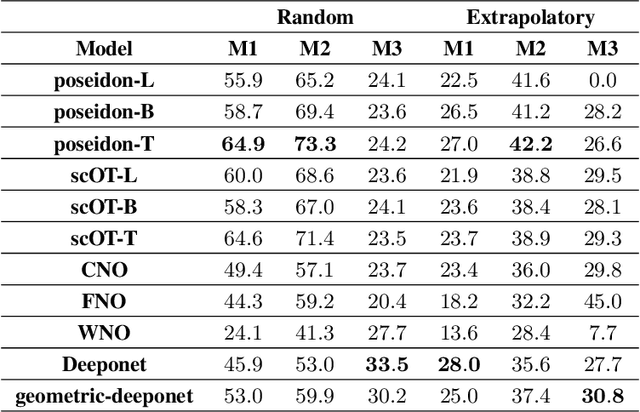
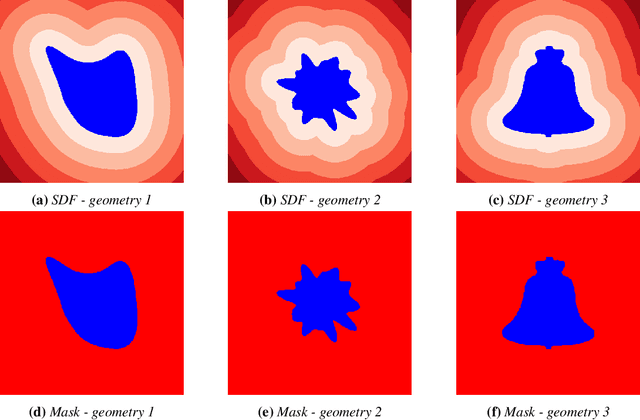
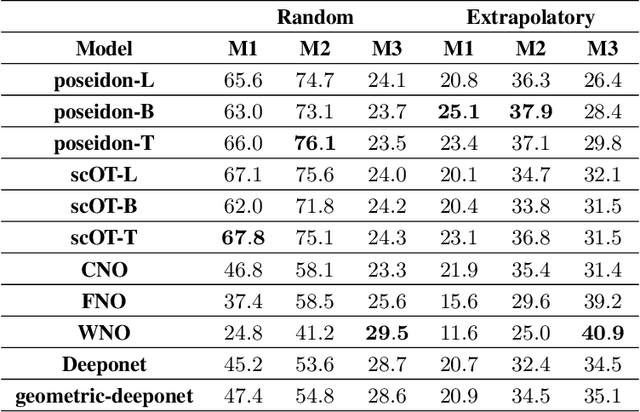
Abstract:Rapid yet accurate simulations of fluid dynamics around complex geometries is critical in a variety of engineering and scientific applications, including aerodynamics and biomedical flows. However, while scientific machine learning (SciML) has shown promise, most studies are constrained to simple geometries, leaving complex, real-world scenarios underexplored. This study addresses this gap by benchmarking diverse SciML models, including neural operators and vision transformer-based foundation models, for fluid flow prediction over intricate geometries. Using a high-fidelity dataset of steady-state flows across various geometries, we evaluate the impact of geometric representations -- Signed Distance Fields (SDF) and binary masks -- on model accuracy, scalability, and generalization. Central to this effort is the introduction of a novel, unified scoring framework that integrates metrics for global accuracy, boundary layer fidelity, and physical consistency to enable a robust, comparative evaluation of model performance. Our findings demonstrate that foundation models significantly outperform neural operators, particularly in data-limited scenarios, and that SDF representations yield superior results with sufficient training data. Despite these advancements, all models struggle with out-of-distribution generalization, highlighting a critical challenge for future SciML applications. By advancing both evaluation methodologies and modeling capabilities, this work paves the way for robust and scalable ML solutions for fluid dynamics across complex geometries.
STITCH: Surface reconstrucTion using Implicit neural representations with Topology Constraints and persistent Homology
Dec 24, 2024



Abstract:We present STITCH, a novel approach for neural implicit surface reconstruction of a sparse and irregularly spaced point cloud while enforcing topological constraints (such as having a single connected component). We develop a new differentiable framework based on persistent homology to formulate topological loss terms that enforce the prior of a single 2-manifold object. Our method demonstrates excellent performance in preserving the topology of complex 3D geometries, evident through both visual and empirical comparisons. We supplement this with a theoretical analysis, and provably show that optimizing the loss with stochastic (sub)gradient descent leads to convergence and enables reconstructing shapes with a single connected component. Our approach showcases the integration of differentiable topological data analysis tools for implicit surface reconstruction.
Robust soybean seed yield estimation using high-throughput ground robot videos
Dec 03, 2024Abstract:We present a novel method for soybean (Glycine max (L.) Merr.) yield estimation leveraging high throughput seed counting via computer vision and deep learning techniques. Traditional methods for collecting yield data are labor-intensive, costly, prone to equipment failures at critical data collection times, and require transportation of equipment across field sites. Computer vision, the field of teaching computers to interpret visual data, allows us to extract detailed yield information directly from images. By treating it as a computer vision task, we report a more efficient alternative, employing a ground robot equipped with fisheye cameras to capture comprehensive videos of soybean plots from which images are extracted in a variety of development programs. These images are processed through the P2PNet-Yield model, a deep learning framework where we combined a Feature Extraction Module (the backbone of the P2PNet-Soy) and a Yield Regression Module to estimate seed yields of soybean plots. Our results are built on three years of yield testing plot data - 8500 in 2021, 2275 in 2022, and 650 in 2023. With these datasets, our approach incorporates several innovations to further improve the accuracy and generalizability of the seed counting and yield estimation architecture, such as the fisheye image correction and data augmentation with random sensor effects. The P2PNet-Yield model achieved a genotype ranking accuracy score of up to 83%. It demonstrates up to a 32% reduction in time to collect yield data as well as costs associated with traditional yield estimation, offering a scalable solution for breeding programs and agricultural productivity enhancement.
FlowBench: A Large Scale Benchmark for Flow Simulation over Complex Geometries
Sep 26, 2024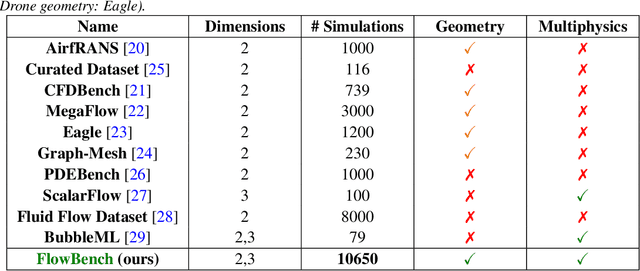

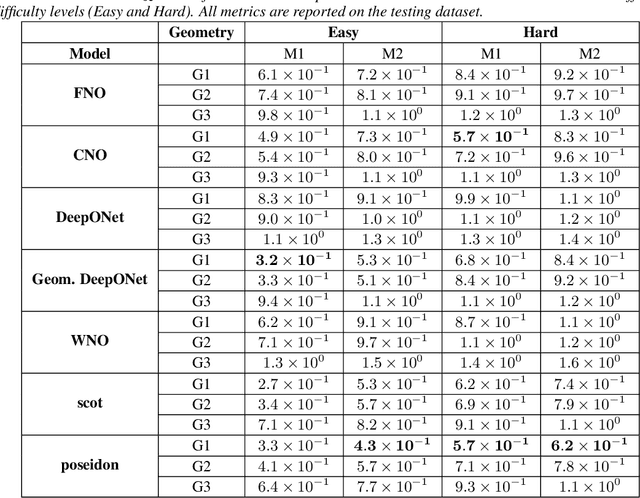
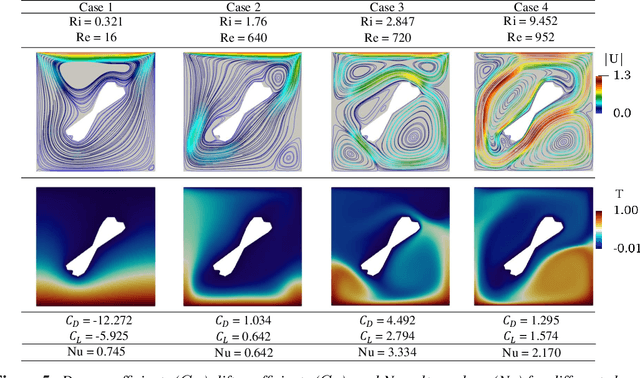
Abstract:Simulating fluid flow around arbitrary shapes is key to solving various engineering problems. However, simulating flow physics across complex geometries remains numerically challenging and computationally resource-intensive, particularly when using conventional PDE solvers. Machine learning methods offer attractive opportunities to create fast and adaptable PDE solvers. However, benchmark datasets to measure the performance of such methods are scarce, especially for flow physics across complex geometries. We introduce FlowBench, a dataset for neural simulators with over 10K samples, which is currently larger than any publicly available flow physics dataset. FlowBench contains flow simulation data across complex geometries (\textit{parametric vs. non-parametric}), spanning a range of flow conditions (\textit{Reynolds number and Grashoff number}), capturing a diverse array of flow phenomena (\textit{steady vs. transient; forced vs. free convection}), and for both 2D and 3D. FlowBench contains over 10K data samples, with each sample the outcome of a fully resolved, direct numerical simulation using a well-validated simulator framework designed for modeling transport phenomena in complex geometries. For each sample, we include velocity, pressure, and temperature field data at 3 different resolutions and several summary statistics features of engineering relevance (such as coefficients of lift and drag, and Nusselt numbers). %Additionally, we include masks and signed distance fields for each shape. We envision that FlowBench will enable evaluating the interplay between complex geometry, coupled flow phenomena, and data sufficiency on the performance of current, and future, neural PDE solvers. We enumerate several evaluation metrics to help rank order the performance of neural PDE solvers. We benchmark the performance of several baseline methods including FNO, CNO, WNO, and DeepONet.
AgGym: An agricultural biotic stress simulation environment for ultra-precision management planning
Sep 01, 2024

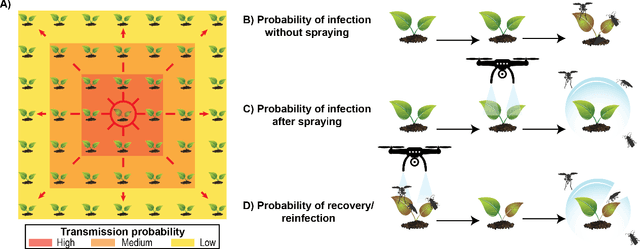
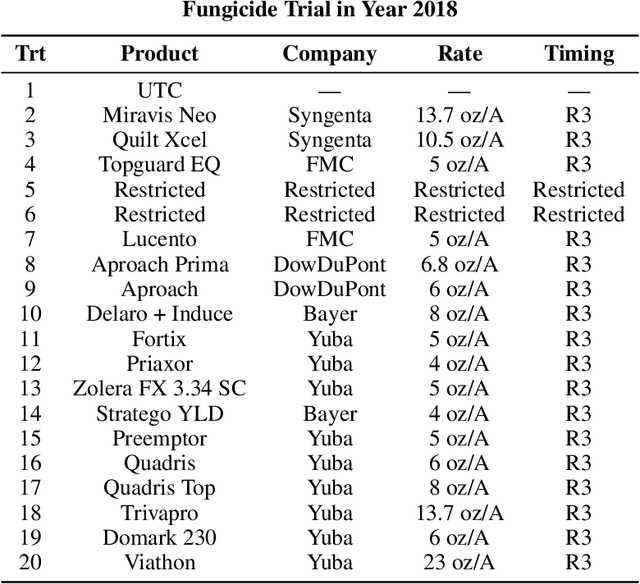
Abstract:Agricultural production requires careful management of inputs such as fungicides, insecticides, and herbicides to ensure a successful crop that is high-yielding, profitable, and of superior seed quality. Current state-of-the-art field crop management relies on coarse-scale crop management strategies, where entire fields are sprayed with pest and disease-controlling chemicals, leading to increased cost and sub-optimal soil and crop management. To overcome these challenges and optimize crop production, we utilize machine learning tools within a virtual field environment to generate localized management plans for farmers to manage biotic threats while maximizing profits. Specifically, we present AgGym, a modular, crop and stress agnostic simulation framework to model the spread of biotic stresses in a field and estimate yield losses with and without chemical treatments. Our validation with real data shows that AgGym can be customized with limited data to simulate yield outcomes under various biotic stress conditions. We further demonstrate that deep reinforcement learning (RL) policies can be trained using AgGym for designing ultra-precise biotic stress mitigation strategies with potential to increase yield recovery with less chemicals and lower cost. Our proposed framework enables personalized decision support that can transform biotic stress management from being schedule based and reactive to opportunistic and prescriptive. We also release the AgGym software implementation as a community resource and invite experts to contribute to this open-sourced publicly available modular environment framework. The source code can be accessed at: https://github.com/SCSLabISU/AgGym.
 Add to Chrome
Add to Chrome Add to Firefox
Add to Firefox Add to Edge
Add to Edge